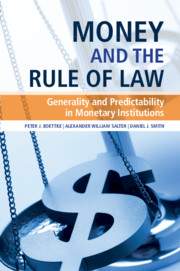Book contents
- Money and the Rule of Law
- Money and the Rule of Law
- Copyright page
- Dedication
- Contents
- Preface
- Acknowledgments
- 1 Introduction
- 2 Knowledge Problems with Discretionary Monetary Policy
- 3 Incentive Problems with Discretionary Central Banking
- 4 When Firefighters Are Arsonists
- 5 On the Shoulders of Giants
- 6 Money and the Rule of Law
- 7 Conclusion
- Index
- References
4 - When Firefighters Are Arsonists
Published online by Cambridge University Press: 13 May 2021
- Money and the Rule of Law
- Money and the Rule of Law
- Copyright page
- Dedication
- Contents
- Preface
- Acknowledgments
- 1 Introduction
- 2 Knowledge Problems with Discretionary Monetary Policy
- 3 Incentive Problems with Discretionary Central Banking
- 4 When Firefighters Are Arsonists
- 5 On the Shoulders of Giants
- 6 Money and the Rule of Law
- 7 Conclusion
- Index
- References
Summary
Financial crises are widely perceived to be the reason monetary rules cannot work. The extraordinary challenges posed by crises require policymakers to act discretionarily. We show that this argument is not only wrong but backward: It is more important than ever to have true rules for monetary policy, which actually bind, to cope with financial crises. We show how the Fed failed to respond appropriately to the 2007–2008 crisis. Contrary to the then chairman Bernanke’s public statements, the Fed did not behave as an orthodox lender of last resort. Instead, it experimented with dubious policies that further entrenched moral hazard in the financial system. We criticize these policies, as well as an approach to economics, which we call “triage economics,” that mistakenly supposes the basic rules of price theory provided no guidance in crafting policy responses to crises. A rules-based approach to monetary policy is thus consistent with extreme market turbulence. In fact, rules are how such turbulence is pacified.
Keywords
- Type
- Chapter
- Information
- Money and the Rule of LawGenerality and Predictability in Monetary Institutions, pp. 94 - 124Publisher: Cambridge University PressPrint publication year: 2021



